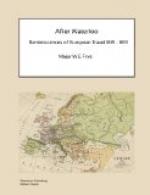among them are several superb dresses of gold and
silver embroidery, so thickly laid on that they are
of exceeding weight. These dresses form part of
the wardrobe of the Virgin Mary. Next to be seen
is a case or chest of massy silver, adorned with innumerable
precious stones of great value; which case contains
the bones or ashes of Charlemagne. His right arm
bone is however preserved separate in a glass case.
The sword of this prince too, and the Imperial crown
is to be seen here. The sacristan next proceeded
to show to us the other relics, but having begun with
the exhibition of a rag dipped in the sweat of Jesus
Christ and a nail of the Holy Cross, we began to think
we had seen enough and went away perfectly satisfied.
There is no other monument in honour of Charlemagne,
but a plain stone on the floor of the Church with
the simple inscription “Carolo Magno.”
On going out of the city thro’ one of the gates,
and at a short distance from it, we ascended the mountain
or rather hill called the Louisberg on which are built
a Ridotto and Cafe, as also a Column erected in honour
of Napoleon with a suitable inscription; the inscription
is effaced and is about to be replaced by another
in the German language in commemoration of the downfall
of the
Tyrant, as the Coalition are pleased
to call him. This Tyrant is however extremely
regretted by the inhabitants of Aix-la-Chapelle and
not without reason, for he was a great benefactor
to them and continually embellished the city, confirming
and increasing its privileges. The inhabitants
are not at all pleased with their new masters; for
the behaviour of the Prussian military has been so
insulting and overbearing towards the burghers and
students that it is, I am told, a common exclamation
among the latter, alluding to the Prussians having
stiled themselves their deliverers:
De nostris
liberatoribus, Domine, libera nos. Indeed,
I can evidently discern that they are not particularly
pleased at the result of the battle of Waterloo.
In the evening I went to the theatre, which has the
most inconvenient form imaginable, being a rectangle.
As anti-Gallicanism is the order of the day, only
German dramas are allowed to be performed and this
night it was the tragedy of Faust, or Dr Faustus as
we term him in England, not the Faust of Goethe, which
is not meant for nor at all adapted to the stage, but
a drama of that name written by Klingmann.[18] It
is a strange wild piece, quite in the German style
and full of horrors and diableries. In this piece
the sublime and terrible border close on the ridiculous;
for instance the Devil and Faust come to drink in
a beer-schenk or ale-house. ’Tis true the
Devil is incognito at the time and is called “der
Fremde” or “the Stranger”; it is
only towards the conclusion of the piece that he discovers
himself to be Satan.... The actor who played
the part of the Stranger had something in his physiognomy
very terrific and awe-inspiring. In another scene,
which to us would appear laughable and absurd, but
which pleases a German audience, three women in masks
come on the stage to meet Faust, in a churchyard, and
on unmasking display three skeleton heads.




